

Hugelkultur: the ultimate raised garden beds. Raised garden bed hugelkultur after one month raised garden bed hugelkultur after one year raised garden bed hugelkultur after two years raised garden bed hugelkultur after twenty years It's a german word and some people can say it all german-ish.
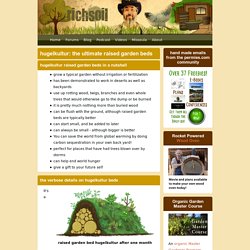
I'm an american doofus, so I say "hoogle culture". I learned this high-falootin word at my permaculture training. Hugelkultur is nothing more than making raised garden beds filled with rotten wood. I do think there are some considerations to keep in mind. Another thing to keep in mind is that wood is high in carbon and will consume nitrogen to do the compost thing.
Pine and fir will have some levels of tanins in them, but I'm guessing that most of that will be gone when the wood has been dead for a few years.
How to Assess Soil Composition. The health of garden plants depends on the soil's composition — the proper balance of mineral pieces, organic matter, air, and water.
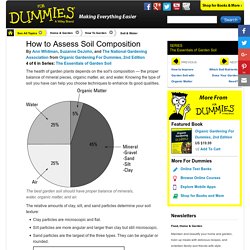
Knowing the type of soil you have can help you choose techniques to enhance its good qualities. The best garden soil should have proper balance of minerals, water, organic matter, and air. The relative amounts of clay, silt, and sand particles determine your soil texture: Clay particles are microscopic and flat. Soil quality considerations in the selection of sites for aquaculture.
Soil is a complex body composed of five major components (Fig. 1.3 namely: mineral matter obtained by the distintergration and decomposition of rocks; organic matter, obtained by the decay of plant residues, animal remains and microbial tissues; water, obtained from the atmosphere and the reactions in soil (chemical, physical and microbial); air or gases, from atmosphere, reactions of roots, microbes and chemicals in the soil organisms, both big (worms, insects) and small (microbes) According to its size, soil can be separated into various fractions.
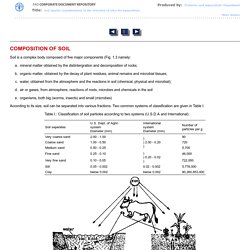
Two common systems of classification are given in Table I. Table I.: Classification of soil particles according to two systems (U.S.D.A and International) Fig. 1.1. Soilcomposition. What is Plate Tectonics? From the deepest ocean trench to the tallest mountain, plate tectonics explains the features and movement of Earth's surface in the present and the past.
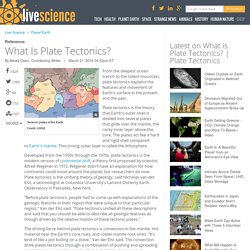
Plate tectonics is the theory that Earth's outer shell is divided into several plates that glide over the mantle, the rocky inner layer above the core. The plates act like a hard and rigid shell compared to Earth's mantle. This strong outer layer is called the lithosphere. Developed from the 1950s through the 1970s, plate tectonics is the modern version of continental drift, a theory first proposed by scientist Alfred Wegener in 1912.
Wegener didn't have an explanation for how continents could move around the planet, but researchers do now. "Before plate tectonics, people had to come up with explanations of the geologic features in their region that were unique to that particular region," Van der Elst said. Bedrock to soil. Oregon state -metal soil measurements: FSbackgroundmetals. International Biochar Initiative. Soil and Health Library. Soil Structure & Composition. Sunday, 06 June 2010 07:35 The Plant Lady Living Matter Mostly in the top 4" of the soil.
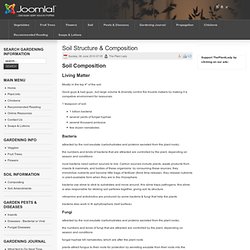
Good guys & bad guys...but large volume & diversity control the trouble makers by making it a competive environment for resources. 1 teaspoon of soil: 1 billion bacteria several yards of fungal hyphae several thousand protozoa few dozen nematodes Bacteria. Geology: Soil. Soil. An important factor influencing the productivity of our planet's various ecosystems is the nature of their soils.
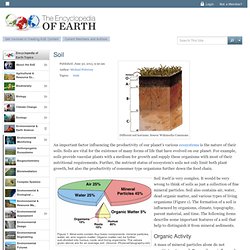
Soils are vital for the existence of many forms of life that have evolved on our planet. For example, soils provide vascular plants with a medium for growth and supply these organisms with most of their nutritional requirements. Further, the nutrient status of ecosystem's soils not only limit both plant growth, but also the productivity of consumer type organisms further down the food chain. Figure 1: Most soils contain four basic components: mineral particles, water, air, and organic matter. Organic matter can be further sub-divided into humus, roots, and living organisms.
Soil itself is very complex. Organic Activity. Soil. Soil is the mixture of minerals, organic matter, gases, liquids and a myriad of micro- and macro- organisms that can support plant life.
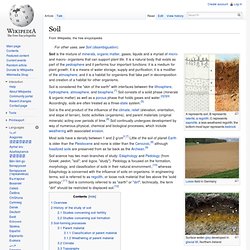
It is a natural body that exists as part of the pedosphere and it performs four important functions: it is a medium for plant growth; it is a means of water storage, supply and purification; it is a modifier of the atmosphere; and it is a habitat for organisms that take part in decomposition and creation of a habitat for other organisms. Soil is considered the "skin of the earth" with interfaces between the lithosphere, hydrosphere, atmosphere, and biosphere.[1] Soil consists of a solid phase (minerals & organic matter) as well as a porous phase that holds gases and water.[2][3][4] Accordingly, soils are often treated as a three-state system.[5] Overview[edit] Soil is a major component of the Earth's ecosystem.
The secret to richer, carbon-capturing soil? Treat your microbes well. Imagine if someone invented machines to suck carbon out of the atmosphere — machines that were absurdly cheap, autonomous, and solar powered, too.
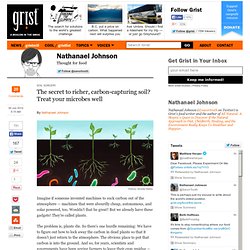
Wouldn’t that be great? But we already have these gadgets! They’re called plants. The problem is, plants die. So there’s one hurdle remaining: We have to figure out how to lock away the carbon in dead plants so that it doesn’t just return to the atmosphere. This has left people scratching their heads. Clive Kirkby was one of those government agents urging farmers to leave dead plant residues in their fields. As he was proselytizing, Kirkby began to bump heads with an agronomist named John Kirkegaard. This made Kirkby crazy. “I’ve been returning the stubble to the ground now for six years, and it’s just not going into the soil,” Kirkegaard told him. Kirkby knew that there must be some mysterious quirk of this topsoil ecosystem that was thwarting him.
The idea that drove Kirkby was elegant in its simplicity. “Humus!” This stopped me.